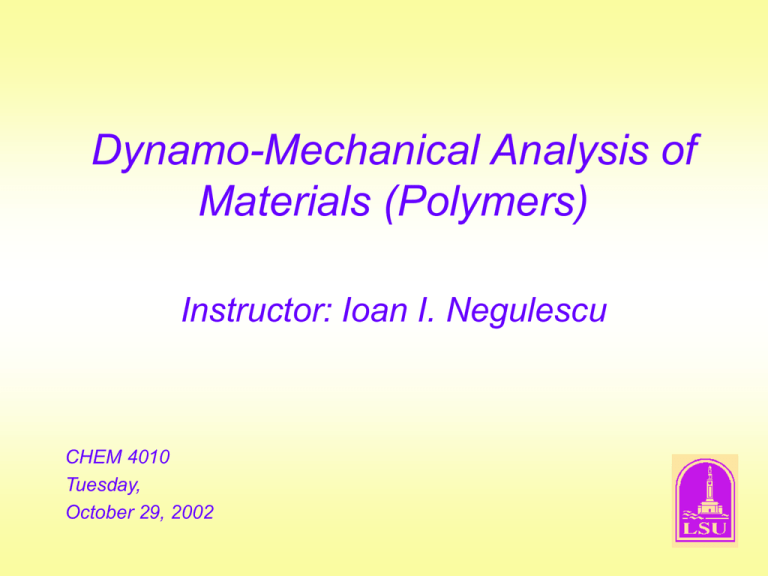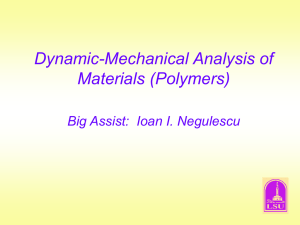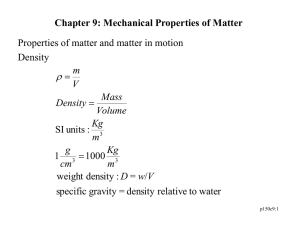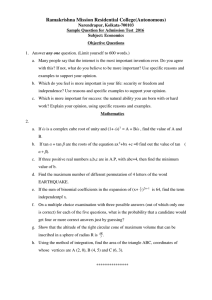Dynamo-Mechanical Analysis of Materials (Polymers) Instructor: Ioan I. Negulescu CHEM 4010
advertisement

Dynamo-Mechanical Analysis of Materials (Polymers) Instructor: Ioan I. Negulescu CHEM 4010 Tuesday, October 29, 2002 Viscoelasticity According to rheology (the science of flow), viscous flow and elasticity are only two extreme forms of the possible types of behavior of matter. It is appropriate to consider the entropic-elastic (or rubberelastic), viscoelastic, and plastic bodies as other special cases. All materials have viscoelasticity, which is a combination of viscosity and elasticity in varying amounts. When this viscoelasticity is measured dynamically, there is a phase shift between the force applied (stress) and the deformation (strain) which occurs in response. The tensile stress and the deformation (strain) are related via the elasticity modulus E as follows: =E Generally the measurements are represented as a complex modulus E* to insure an accurate expression: E* = E’ + iE” where: i2 = -1 In dynamic mechanical analysis, DMA, a sinusoidal strain or stress is applied to a sample and the response is monitored as a function of frequency. Polymers are not ideal energy elastic bodies; they are viscoelastic materials. In such cases the deformation (strain) lags behind the applied stress. Schematic representation of the stress as a function of time t with dynamic (sinusoidal) loading (strain). COMPLEX MODULUS: E*=E’ + iE” I E* I = Peak Stress / Peak Strain o STRESS STRAIN o 0 / 2 / STORAGE ( Elastic) MODULUS I E' I = I E* I cos t LOSS MODULUS I E" I = I E* I sin Parallel-plate geometry for shearing of viscous materials (DSR instrument). The “E”s above (Young modulus) can all be replaced with “G”s (rigidity modulus). Therefore one may write an equation similar to that for E*: G* = G’ + iG" where the shearing stress and the deformation (strain) are related via the rigidity modulus G as follows: =G Definition of elastic and viscous materials under shear. In analyzing the polymeric materials, G*, the ratio of the peak stress to the peak strain, reflects the total stiffness. The in-phase component of IG*I, i. e. the shear storage modulus G', represents the part of the input energy which is not lost to heat (the elastic portion). The out-of-phase component, i. e. the shear loss modulus G" represents viscous component of G*, viz., it reflects the loss of useful mechanical energy through dissipation as heat. The complex dynamic shear viscosity * can be obtained from G* divided by the frequency, while the dynamic viscosity is = G"/ or = G"/2f For purely elastic materials, the phase angle will be zero, whereas for purely viscous materials, the phase angle will be 90. Thus, the phase angle, expressed as tangent, is an important parameter for describing the viscoelastic properties of a material. The loss tangent is calculated simply as the tangent of the phase angle, or alternatively, as the ratio of the loss, to storage moduli: tan = G"/ G', because G" = G*sin and G' = G*cos. There is a general tendency in dynamic viscoelasticity measurements for the detected transition temperature to shift when the measurement frequency is changed. This phenomenon is based on a principle called the time-temperature superposition principle, where the transition temperature (for example the top peak temperature of tan) tends to rise when the measurement frequency is increased. Dynamic mechanical analysis of a viscous polymer solution. Dependence of tan on frequency. • DMA techniques are very sensitive to temperature changes. • Secondary transitions, observed with difficulty by DSC or DTA techniques, are clearly evidenced by DMA. • Any thermal transition in polymers will generate a peak for tan and E" or G". • The peak maxima for G" (or E") and tan do not occur at the same temperature. Dynamic mechanical analysis of recyclable HDPE. Dependence of tan on frequency. The transition is seen at 62C and transition occurs at -117C. Dependence of G", G' and of their ratio (tan) on frequency for a sample of HDPE analyzed at constant temperature (180C). Data obtained with 2C/min showing the glass transition at about -40C (read as tan or E" maxima) and a false transition at 15.5C due to the nonlinear increase of temperature versus time. 1.0 E' m Te 80 E" tan 0.6 40 tan 0.4 0.0 15.5oC tan -40 E' E" Temperature -80 0.2 0.0 -10 0 10 20 30 40 50 60 Time, min 70 80 90 100 110 Temperature, oC Continental Carbon Sample A-97058 0.8 re tu a r pe Dynamo-mechanical analysis of low crystallinity poly(lactic acid): Dependence of tan upon the temperature and frequency for the 1st heating run Tg 0.8 o 62 C 0.6 o 69 C Crystallization tan o 75 C Crystallization 0.4 1.0 Hz 50 Hz Tg o 66 C 0.2 0.0 PLALC 30 40 50 60 70 80 o Temperature, C 90 100 Dynamo-mechanical analysis of the Low Crystallinity Poly(lactic acid). Dependence of the storage modulus upon the thermal history. 2G Storage Modulus (Pa) st E' @ 10 Hz (1 h) nd E' @ 10 Hz (2 h) st 1 heating Crystallization (Stiffening) 1G Glass Transition Tg T CR 2 70 80 nd heating 10 Hz PLALC 0 40 50 60 o Temperature, C 90 100





